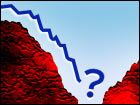
NEW YORK (CNN/Money) -
The stock market had investors reaching for the Dramamine Monday, kicking off the day with one of the worst selloffs in recent memory and then clawing most of the way back (see more).
Once again, investors are left to wonder where the drama will end. Was the sharp rebound it, the signal that the worst is over and that it's time to jump back into the market? Or was it just another bear-market bounce?
The sad truth is, no one knows for sure when the bottom will come. Just as the market in the 1990s zoomed much higher for much longer than anyone could have guessed, the selling's been more intense than anyone imagined.
But just about everyone agrees that the time to get in is when "everybody" else is getting out. Here's what the experts say about getting back in the market.
The washout
When the bottom finally comes, according to Hilliard Lyons technical analyst Richard Dickson, it will be in a crescendo of fear. Investors will blindly sell, happy to get out at any price. Stocks will careen lower.
"Everybody who wants to sell will have sold," explains Dickson. "Supply will be exhausted."
Dickson says he'll know the "washout" has happened when daily trading volume on stocks that finish lower exceeds the volume of those that gained by at least 9 to 1. In recent days the market has gotten close to this magic level, but it hasn't quite hit it yet.
Fear alone isn't enough, says Dickson -- for a bottom you need to see greed, too. Within a few days of the intense selling, he wants to see intense buying -- proof that stocks have got to a point where long-term investors are again picking up shares.
A bear on cover of Time
Once the selling hits the cover of a major news magazine -- preferably Time or Newsweek -- the bottom has arrived, according to Legg Mason strategist Paul Macrae Montgomery. The theory? If the editors at one of those outfits decide the market is bad enough to make the cover, it can't get any worse.
Fact is, the theory's worked. Newsweek put a wild bear on its cover in April 1994 and went with a black cover, "The Crash of '99?", in October 1998. Both proved great times to buy. "When the financial news makes a cover [of a general interest magazine] it's almost always worth acting on," says Macrae Montgomery. "Unfortunately, I haven't seen it yet."
Indeed, while the latest issues of Time and Newsweek cover financial news prominently both their cover stories are on, alas, hormone therapy.
When we stop asking...
Merrill Lynch strategist Rich Bernstein has a standard answer for reporters who ask him when the market will bottom: "When people like you stop writing these stories."
Everybody trying to figure out when the market will bottom just shows how much of a pull the stock market has on us. But true bottoms come when disgust with the market has faded to disinterest. In 1982, the chatter down at the pool was how much money markets were yielding; meanwhile the bull market in stocks was just beginning.
"The opposite of I love you is not I hate you," says Bernstein. "It's I don't care."
It doesn't matter -- stocks are cheap
"Who the [heck] knows where the bottom is," says Credit Suisse Asset Management managing director Stanley Nabi. "I've been going into the market small step by small step for the past few weeks. All I've been doing is buying."
Nabi, wildly bearish in the last months of the bull market, says that even under his conservative expectations for earnings stocks are something like 18 percent below where they should be. Nabi's not alone. P/Es have fallen and interest rates are incredibly low. A popular stock valuation that uses both those things (it's called the Fed Model because some people think Alan Greenspan uses it) shows stocks are 25 percent too cheap (see more).
Vindication could be a long way off. But with the benchmark S&P 500 at its lowest level in five years, you hold your nose and buy, says Nabi.

|

